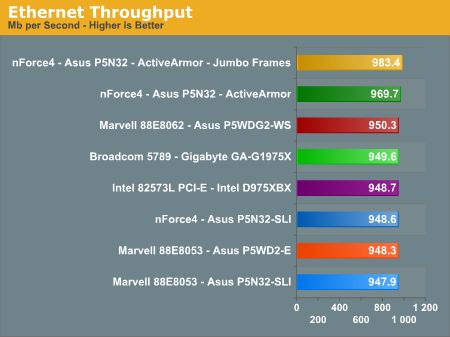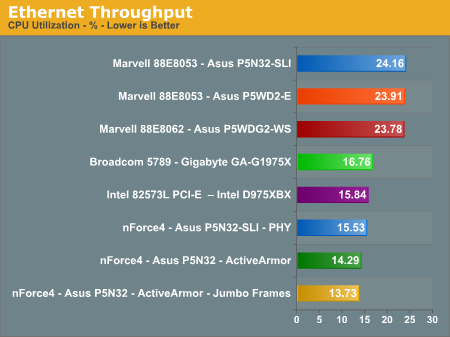Intel D975XBX: Intel brings their Bad-Axe to Market
by Gary Key on January 26, 2006 12:05 AM EST- Posted in
- Motherboards
Ethernet Performance
The current motherboard test suite includes LAN performance measurements. All of these boards utilize PCI Express controllers with the only difference being the supplier of the core logic.
The Windows 2000 Driver Development Kit (DDK) includes a useful LAN testing utility called NTttcp. We used the NTttcp tool to test Ethernet throughput and the CPU utilization of the various Ethernet Controllers used on the Intel 975x motherboards.
We set up one machine as the server; in this test, an Intel system with an Intel CSA Gigabit LAN connection. Intel CSA has a reputation for providing fast throughput and this seemed a reasonable choice to serve our Gigabit LAN clients.
At the server side, we used the following Command Line as suggested by the VIA whitepaper on LAN testing:
All standard Ethernet tests were performed with standard frames and the NVIDIA Active Armor suite disabled unless otherwise noted. Gigabit Ethernet supports Jumbo frames as well and provides a further reduction in CPU overhead. We added another test scenario in which ActiveArmor and Jumbo frames were enabled on the Asus P5N32-SLI Deluxe board via the 6.82 WHQL platform driver set. This is shown for illustrative purposes and shows the favorable impact of this technology.
The current motherboard test suite includes LAN performance measurements. All of these boards utilize PCI Express controllers with the only difference being the supplier of the core logic.
The Windows 2000 Driver Development Kit (DDK) includes a useful LAN testing utility called NTttcp. We used the NTttcp tool to test Ethernet throughput and the CPU utilization of the various Ethernet Controllers used on the Intel 975x motherboards.
We set up one machine as the server; in this test, an Intel system with an Intel CSA Gigabit LAN connection. Intel CSA has a reputation for providing fast throughput and this seemed a reasonable choice to serve our Gigabit LAN clients.
At the server side, we used the following Command Line as suggested by the VIA whitepaper on LAN testing:
Ntttcpr -m 4,0,‹server IP› -a 4 -l 256000 -n 30000On the client side (the motherboard under test), we used the following Command Line:
Ntttcps -m 4,0,‹client IP› -a 4 -l 256000 -n 30000At the conclusion of the test, we captured the throughput and CPU utilization figures from the client screen.


All standard Ethernet tests were performed with standard frames and the NVIDIA Active Armor suite disabled unless otherwise noted. Gigabit Ethernet supports Jumbo frames as well and provides a further reduction in CPU overhead. We added another test scenario in which ActiveArmor and Jumbo frames were enabled on the Asus P5N32-SLI Deluxe board via the 6.82 WHQL platform driver set. This is shown for illustrative purposes and shows the favorable impact of this technology.










34 Comments
View All Comments
Gary Key - Saturday, February 11, 2006 - link
Actually, depending upon the device PCI-E does support single-ended transfers. I probably should have worded my statement differently.
Bozo Galora - Thursday, January 26, 2006 - link
http://img264.imageshack.us/my.php?image=intoilet3...">http://img264.imageshack.us/my.php?image=intoilet3...Zebo - Friday, January 27, 2006 - link
It's pretty sad Garys great article is'nt being read more - only 16 replies almost two days later - he can blame intel and thier non-exciting chips ATM.Gary Key - Friday, January 27, 2006 - link
I should have put "Conroe Comes to Town" in the headline. ;-) At least the board is showing the 1333 fsb setting, hint, hint. Intel's products are a little mundane at the moment but at least we have 20 replies now, anything less and I owed my dog a Big Mac.danidentity - Thursday, January 26, 2006 - link
Do you guys plan on doing a 975X motherboard roundup in the future? If so, when is it going to be ready?Gary Key - Thursday, January 26, 2006 - link
We have three more 975x boards to review. I estimate in about three weeks the roundup will be ready.
danidentity - Thursday, January 26, 2006 - link
Thanks Gary. Also, is there any word on whether 975X will support Conroe?Gary Key - Thursday, January 26, 2006 - link
We continue to ask this question. As soon as we have an answer it will be front page news. :-) This board officially supports the 1333 fsb that we will see on product launches this summer but whether they will respin the 975x or not is up in the air right now.
AGAC - Thursday, January 26, 2006 - link
The lack of performance, specialy when compared to an AMD similarly priced system should be compensated with a richer array of features. Looks like intel failed at that. Couple that with a higher energy bill, hotter/noisier computer and there you may explain why so many people now have AMD systems. For me, my last intel PC was a Pentium III. It was good for over 7 years, went from my home to my office untill a cheaply configured Sempron recently put it out of it's duties.AGAC - Thursday, January 26, 2006 - link
Can enyone tell me why? Is this "William Shakespeare inside" some spiner's new trend? And while we're talking about intel's marketing strategy what's all the hype with this viiv thang?